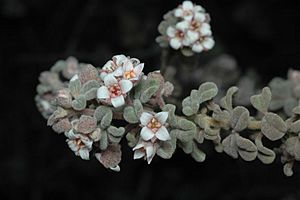Bomaderry zieria facts for kids
Quick facts for kids Bomaderry zieria |
|
|---|---|
 |
|
| Conservation status | |
| Scientific classification | |
| Genus: |
Zieria
|
| Species: |
baeuerlenii
|
The Zieria baeuerlenii, also known as the Bomaderry zieria, is a special plant. It belongs to the citrus family called Rutaceae. This plant is only found in a small area on the south coast of New South Wales, Australia. It's a shrub that can sometimes look a bit messy. Its leaves feel soft like velvet and have three small parts called leaflets.
From late autumn to spring, you can see its small white or pinkish flowers. These flowers grow in groups. They have four petals. Interestingly, these flowers don't seem to be able to make seeds.
Contents
What Does the Bomaderry Zieria Look Like?
The Bomaderry zieria is a shrub that spreads out. It usually grows to about 0.8 meters (about 2.6 feet) tall. Its younger branches are covered in soft, velvety hairs. The leaves grow in pairs, one across from the other. Each leaf has three smaller parts, or leaflets.
Leaves and Leaflets
The middle leaflet is shaped like a heart. It is narrower at the bottom. This leaflet is usually 6 to 12 millimeters (about 0.2 to 0.5 inches) long. It is also 4 to 9 millimeters (about 0.16 to 0.35 inches) wide. It has a small stem about 1.5 to 2.5 millimeters (about 0.06 to 0.1 inches) long. The other two leaflets are similar but a bit smaller. All the leaflets have soft, velvety hairs. Their edges are also rolled under.
Flowers and How They Grow
The Bomaderry zieria has many small, pinkish-white flowers. Each flower is about 8 millimeters (about 0.3 inches) across. They grow in groups of three to seven flowers. These groups appear where the leaves meet the stem, which is called a leaf axil. Each flower group has a stalk up to 10 millimeters (about 0.4 inches) long. This stalk is longer than the leaves.
There are four large, green, leaf-like parts called bracts around each flower group. The sepals are triangle-shaped. They are about 2 millimeters (about 0.08 inches) long. These sepals are also covered with velvety hairs. The four petals are shaped like a broad spear. They are about 3 millimeters (about 0.12 inches) long. The petals overlap each other. They have a layer of hairs on the outside.
The Bomaderry zieria flowers from September to October. However, no one has ever seen it produce fruit. Scientists think this plant has lost its ability to make seeds.
How the Bomaderry Zieria Got Its Name
The Bomaderry zieria was officially described in 2002. This was done by a scientist named James Andrew Anderson. He found a sample of the plant near Bomaderry Creek. The description was published in a science journal called Australian Systematic Botany.
The second part of its scientific name, baeuerlenii, honors a plant collector. His name was Wilhelm Baeuerlen. He was born in Germany. He moved to Australia around 1883. Wilhelm lived in the Shoalhaven area. He collected plants for other famous scientists.
Where the Bomaderry Zieria Lives
The Bomaderry zieria is only found in a very small area. This area is about 0.5 square kilometers (about 124 acres) in size. It is located near Bomaderry. The plant grows in soil that comes from sandstone. You can find it in forests, woodlands, and scrub areas.
How the Bomaderry Zieria Reproduces
Scientists have never seen the Bomaderry zieria produce fruit or seeds. They believe the plant has lost its ability to reproduce sexually. This means it cannot make new plants from seeds. Instead, it likely grows new plants from suckers. Suckers are new shoots that grow from the base of the plant. This plant can also grow back after a bushfire.
Protecting the Bomaderry Zieria
The Bomaderry zieria is considered "Endangered." This means it is at high risk of disappearing forever. It is listed as endangered under two important laws. These are the New South Wales Threatened Species Conservation Act and the Australian Government's Environment Protection and Biodiversity Conservation Act 1999 (EPBC) Act.
There are several things that threaten this special plant. These include damage to its home from illegal activities. Weeds can also invade its living space. Rabbits sometimes eat the plants. Frequent fires are another big danger to the Bomaderry zieria.
Images for kids



